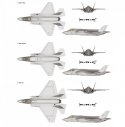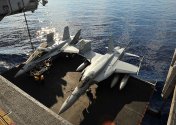Personally I agree with the thought that J-20 is ready, more proven, more capable than J-35/xy because it has to be... it's larger and can accommodate more things, powered by more powerful engines. These should translate to electronic advantages not to mention better range and payload which are certainly important for any fighter. The issue is we don't have all the information from which these decision are based on. It could have been in the "wisdom" of the decision makers that on the grand scheme of things, an inferior fighter from SAC is more suitable for PLANAF simply because SAC should have the work. It could be nothing more than that (but I doubt).
The general conclusion based on this is that the J-35/xy is more suited to the carrier role because the advantage of being able to squeeze more fighters in 00x carrier more than compensates for any would be loss of capability if a J-20 navy variant was developed. All of this stuff should have been carefully calculated and likely conflict scenarios and SWOT assessment being considered. As a more regional defensive role, a smaller fighter may have been considered acceptable so that an extra one or two fighters could fit on the 003 and who knows what the plan is for 004 and onwards. They would have thought J-xy and Type 004 when making the decisions.
As for J-20 being flanker sized, well it's still larger than the J-35/xy and while the wingspan is similar, it's much longer and surely heavier.
Actually on the topic of J-20 vs fc-31 as a carrier fighter, I also agree that looking purely at the fighters themselves J-20 is a better aircraft with bigger load, longer range, larger radar etc etc. However, as for a carrier borne aircraft, we can’t just focus on the performance of aircraft alone but we must consider the intrinsic qualities of aircraft that may allow the air wing to perform better as a whole and as a system. The key advantages of fc-31 over J-20 can be summaries in 2 ways:
Suitability for carrier landings. Bear in mind that landings on carriers are the most dangerous and technically challenging part of the whole carrier ops. Most carrier borne fighter designs tries to maximize low stall speed at low angle of attack (AOA). While canard designs like the J-20 have a low stall speed due to the canards, it still tends to have a high AOA and high wing loading due to the inherent design of the planform. While the Rafale serves as a carrier born fighter, it still has a higher AOA during landing than typical USN fighters while probably still having lower wing loading than J-20, and that’s considering that’s its designed to be a carrier fighter to begin with, which the J-20 was not. It’s a reasonable compromise for a smaller force for France with limited budget but it’s not the most ideal solution. The conventional platform has inherent advantages of the main wing being close to the CG and thus increasing wing area to decrease wing loading would not require a dramatic redesign of the entire layout of the aircraft, whereas modifications to adapt J-20 would pretty much entail a complete redesign of the aircraft. Thus, much similar to the F-35 program, it maybe much more cost and time efficient to adapt FC-31 to a carrier capable aircraft.

Another point to consider is size. The smaller size of FC-31 is not just for the sake of ‘squeezing more planes’ into a carrier, but more for an efficiency of deck operations. Having a smaller footprint is going to allow more ready aircrafts on the deck, maybe 2 planes per trip on the elevator, especially considering the Type-003 is only going to have 2 elevators and currently Liaoning can only carry 1 plane per elevator per trip vs 2 hornets on USN CVNs. However big a carrier may seem, its deck and hanger space is always in short supply. Smaller planes means more space for maintenance, repairs, rearm is always appreciated, and intrinsically increases combat readiness and effectiveness that can’t be measured with just the plane’s specifications alone.

Just my 2 cents.



